Terrorism has to be wiped out militarily and cannot be tackled politically. That’s the basic premise of the Rajapakse Model.
Conduct of Operations
This is how the Sri Lankan government described (through a Ministry of Defence Press Release) the war strategy of its defence forces on May 18, 2009 after the annihilation of the LTTE.
“Security forces have marked a decisive victory in the humanitarian operations launched against terrorism by killing almost all senior cadres of the LTTE. The security forces commenced this humanitarian operation in August 2006 by liberating the Maavil Aru Anicut with the objective of wiping out terrorism from the country. An area of 15,000 square kilometres was controlled by the LTTE terrorists by 2006. Now the forces have completely liberated the entire territory of Sri Lanka from the LTTE terrorists. After liberating the Eastern Province from the clutches of terrorism on the 11th of July in 2007, the troops launched the Wanni humanitarian operation to liberate the innocent civilians from the terrorists in 2007.”
Security forces have marked a decisive victory in the humanitarian operations launched against terrorism by killing almost all senior cadres of the LTTE.
“The operation was launched by three battle fronts. On March 2007, the 57th Division of the Army under the command of Major General Jagath Dias commencing its operations from Vavuniya marched towards the North. They gained control of the Kilinochchi town on the 2nd of January this year, which was considered as the heartland of the LTTE. In parallel to this, the 58th division, then Task Force One, commanded by Brigadier Shavendra Silva commenced its operations from the Silavathura area in Mannar in the western coast of the island. After capturing Poonaryne and gaining total control along the western coast the Division moved towards Paranthan. Subsequently, the 58th Division then captured Elephant Pass, Paranthan, Kilinochchi, Sundarapuram, Pudukudiyiruppu and finally the eastern coast of the country. The 58th Division has recorded the most number of victories against the LTTE during the course of the humanitarian operation. The 59th division of the Army, commanded by Major General Nandana Udawatta opened another battle front in Welioya area in January 2008. The troops of this division achieved a land mark victory on the 25th of January this year by capturing the LTTE administrative hub, Mullaitivu.”
“Meanwhile, the 53rd and 55th Divisions of the Army supervised by Major General Kamal Gunarathne and Brigadier Prasanna Silva respectively, conducted their operations beyond the Muhamale and Nagar Kovil Forward Defence Line. They consolidated Elephant Pass and Chalai, marking the liberation of the entire Jaffna peninsula from the terrorists. A total of five Divisions and four Task Forces were engaged in operations against the LTTE in the recent past. Entering the last phase of the Wanni humanitarian operations troops of the 53rd, 55th, 58th and 59th Divisions jointly conducted the world’s largest hostage rescue operation and liberated nearly 263,000 civilians by yesterday (May 17, 2009) morning. With liberating all the civilians held as hostages by the LTTE the military operations against the LTTE have reached a decisive juncture with the security forces entrapping the top LTTE rankers to a small patch of land in Mullativu. The Army has launched massive attacks targeting leaders of the LTTE since last night. Almost all top LTTE leaders were killed in these attacks and the troops have also recovered all their bodies.”
“The Air Force, the Navy as well as the Police also contributed a lot for the success of these operations. Destroying of ten ships of the LTTE considered as floating arms storages could be defined as another significant achievement by the Navy. This helped a lot to destroy the military strength of the terrorists. The Navy also implemented a special marine security programme to avert possible escape of LTTE leaders via sea routes. Parallel to this, the Air Force carried out accurate air raids on identified LTTE targets. Indicating the accuracy of the air raids of the Sri Lankan Air Force, on 2nd of November 2007, then LTTE political head Thamil Selvan and four senior LTTE cadres were killed in an air raid. By transporting injured troops and their requirements the Air Force played a pivotal role in the fight against terrorism. Parallel to this the Police secured the law and order of the country by averting LTTE activities to disrupt the day to day life in the south. Detaining LTTE suspects and recovery of large hauls of weapons by the Police was another reason for the success of the Wanni humanitarian operation.”
This official version of the war operations by the Ministry of Defence was released after being vetted by Defence Secretary Gothabaya Rajapakse. Careful planning and crafty military tactics led to the swift and surgical defeat and elimination of the LTTE. Even as the Ceasefire Agreement (CFA) was called off in January 2008, the Sri Lankan armed forces were well stocked with multi-barrel rocket launchers, heavy artillery, precision guided missiles and bunker busters. Between 2002 and 2005 the recorded violations of the CFA by the LTTE stood at 3,800 while the government committed 350 violations. After two major attacks by the LTTE in the North and the East and the assassination attempt of General Sarath Fonseka by a pregnant suicide bomber, President Mahinda Rajapakse ordered the commencement of military operations to militarily eliminate the LTTE. In 2007 the East was liberated and Karuna, a LTTE child soldier who grew up to take over as the terror outfit’s Eastern Commander, and then eventually broke away in 2004, was made the Chief Minister of the eastern province.
By December 2008 the Sri Lankan Air Force had launched 400 air strikes. The LTTE realized that it had under-estimated the resolve and resources of the Sri Lankan Army and that it just did not have the depth to fight a conventional war. So as the military advanced, the LTTE retreated taking the civilians with them. When the troops marched into Kilnochchi, the HQs of the LTTE, it was a ghost town. By April 2009 the LTTE along with its civilian captives were boxed in a 12 km stretch of coastal land, which the government declared as a No Fire Zone. It was declared as a civilian safety zone, which basically meant that the military would not resort to heavy artillery bombardment inside this zone to avoid civilian casualties. The daring military operation to rescue the entrapped civilians and the eventnal killing of the top LTTE leadership is described by the Sri Lankan government as the “biggest humanitarian operation” in the world. It is indeed one of the most fascinating surgical military operations ever undertaken. Eventually 300,000 civilians were liberated and housed in the Menik Relief Camps in Vavuniya. In the early days of April 2009 the official government estimate was merely 70,000.
So how did the military prise open the human shield, liberate the civilians and get to the LTTE leadership? Here’s the inside story. By the third week of April, the LTTE along with their civilian captives were bottled up in a rectangular 12 km No Fire Zone (NFZ) coastal stretch, with the Nanthi Kadal (lagoon) on the West and the Indian Ocean on the East. The Navy had set up a marine cordon sanitaire and the army laid siege on the land with troops of the 59 Division covering the West and Southern sides of the lagoon and the 53, 55 and 58 Divisions choking North and North-West approaches. The objective of the military operation was to bifurcate this last coastal stretch under LTTE occupation to facilitate the escape of entrapped civilians. The long coastal stretch from South of Chalai, once a major Sea Tiger base, to Karayamullivaikai was already under army control. On April 18, 2009 Lt General Sarath Fonseka spent his day at the Field Headquarters confabulating with his core team of army commanders and studying the aerial surveillance visuals taken by the Unmanned Aerial Vehicles (UAVs) of the Sri Lankan Air Force. But what was critical to the success of the Army was the stupendously brave and accurate ground intelligence gathering by troops of the Long Range Reconnaissance Patrol (LRRP). Elements from LRRP had infiltrated the NFZ where the LTTE was holed up disguised as civilians and these army intelligence operatives provided the crucial inside information that eventually proved crucial for the success of the military operations.
From the Field HQ in Vauniya, General Fonseka hooked up on the army line with Brigadier Shavendra Silva, one of the illustrious war heroes of Sri Lanka. He told Brigadier Silva that the plan to launch the “biggest hostage rescue operation” in the world was final and that he was being tasked to execute it. Brigadier Silva, commander of the 58 Division, by then had already accumulated a trail of glorious battle milestones from Mannar in the West Coast to Mullaitivu in the East.
The plan was simple: Breach the LTTE’s Defence Lines and create a safe passage for the entrapped civilians to escape.
The 58 Division, positioned just 300 metres away from the NFZ, had faced the brunt of LTTE suicide attacks for more than a week as the LTTE desperately tried to prevent the army’s final assault. Waves of suicide bombers tried to breach 58 Divisions defences at Velayanmadam, Puthumatallan and east of Puthukkudiyirippu. But the brave soldiers of this Division continued their formidable and aggressive hold of the Forward Defence Line. Brigadier Silva was given a free hand to put together his best team for the final assault on the LTTE to free the trapped Tamil civilians. The 9th Gemmu Watch Battalion, 8th Gajaba Battalion, 11th Sri Lanka Light Infantry Battalion, the 2nd Commando Battalion under the command of Colonel Ralph Nugera and 1st Special Forces Battalion under the command of Colonel Athula Kodippili were handpicked for the rescue operation.
The plan was simple: Breach the LTTE’s Defence Lines and create a safe passage for the entrapped civilians to escape. But this was easier said than done because the LTTE had built a three kilometer earth wall or bundh from Puthumatallan to Ampalavanpokkanai. Behind this earth wall were the bulk of the civilians who were being used as human shields. Three attack formations were constituted. The Alpha Group comprising the 2nd Commando troops along with the 8th Gajaba Battalion were tasked to attack the northern edge of the earth bundh. The Bravo Group comprising 1st Special Forces and the 11th Sri Lankan Light Infantry were to assault the southern edge of the earth bundh and the 9th Gemmu Watch Battalion, the Charlie Group, was tasked to clear a safe passage for civilian egress.
On a dark Sunday night, April 18, at 11.40 pm, the rescue operation began as all assault formations equipped with night vision devices quietly waded through the Nanthi Kadal lagoon, advancing deep into enemy lines. The troops were given 2 am as the H Hour to reach the earth bund. The moment the troops reached the bundh they engaged the LTTE guard positions on the earth wall. The LTTE offered stiff resistance firing mortars and heavy artillery, but were soon overpowered by superior tactics and reinforcements from the 58 Division. Even as the troops overran LTTE defences, the Charlie Group of the 58 Division cleared mines and IEDs and provided covering fire for the civilians to rush over to government controlled territory secured by 55 Division. Immediately, check points were set up to screen the escaping civilians to ensure that LTTE suicide bombers didn’t cross over in the melee. As dawn broke on April 19, more than 41,000 civilians had crossed over into army controlled area north of Puthumatalan. On same day again in the dead of the night the second phase of the operation was launched to cut off the LTTE’s access to the coast as troops of the 58 Division tried to link up with troops of the 55 Division advancing along the coast.
By now the LTTE had been squeezed into a 5 km zone with its access to sea severely constrained.
The link-up of the two army divisions eventually happened by Wednesday – April 21, 2009. By then more than 100,000 civilians had escaped from the LTTE’s clutches. Amongst them were Daya Master, LTTE media spokesman and George Master, English Translator of the LTTE leadership. As they crossed over the army check point at Puthumatalan, a civilian spotter employed by the Army identified them and immediately alerted the troops. The duo were immediately taken into custody and transported to Colombo for interrogation. Hundreds of LTTE fighters disguised as civilians also crossed over into army controlled area. Many including child soldiers were apprehended. At the last count more than 3,000 LTTE cadres were arrested as they tried to cross over from the NFZ as civilians.
By now the LTTE had been squeezed into a 5 km zone with its access to sea severely constrained. Exactly a month after the rescue operation was launched the LTTE was exterminated on May 18, 2009. Two days before this momentous development the LTTE tamely admitted defeat, marking the end of Asia’s longest running civil war that left approximately more than 70,000 dead in pitched battles, suicide attacks, bomb strikes and assassinations. On May 16, 2009 Selvarasa Pathmanathan, the LTTE’s chief of international relations, said in a statement on the pro-rebel Tamilnet website that the war was at “its bitter end”. “We have decided to silence our guns. Our only regrets are for the lives lost and that we could not hold out for longer,” he added, calling for peace negotiations. But the military refused to let up in their offensive, saying troops were pushing on to recapture “every inch of land” held by the LTTE, which at that point in time was estimated at less than a square kilometre (half a square mile) of jungle. Forty eight hours later it was all over as the government information department sent out a text message to cell phones across the country announcing the killing of Prabhakaran along with his top deputies, Sea Tigers Commander Soosai and LTTE’s intelligence chief, Pottu Amman.
The Eight Fundamentals of Victory
The news about the killing of Prabhakaran sparked mass celebrations around the country, and people poured into the streets of Colombo, dancing and singing. Looking back at the war General Fonseka made two insightful observations that must surely resonate in the minds of military strategists dealing with terrorism and insurgency in other parts of the world. The first is on the commitment of the political leadership to eliminate terror.
Eelam IV war began as a poll-promise. President Mahinda Rajapakse rode to power four years ago vowing to annihilate the LTTE. In the early hours of Tuesday the fight for Eelam, a separate homeland for the Tamils in Sri Lanka, begun in 1983 ended in a lagoon, the Nanthi Kadal. Vellupillai Prabhakaran’s dead body, eyes wide open, top portion of the head blown off, the thick bushy moustache in place, was found in the lagoon by the Sri Lankan forces looking for remnant LTTE stragglers.
In the President’s Office in Colombo officials talk about the ‘Rajapakse Model’ (of fighting terror). “Broadly, win back the LTTE held areas, eliminate the top LTTE leadership and give the Tamils a political solution.” Sunimal Fernando, one of Rajapakse’s advisors, says that the President demonstrated a basic resolve: “given the political will, the military can crush terrorism.” This is not as simple as it sounds. Like most poll promises he did not have plans to fulfil his promise to militarily defeat the LTTE. Eelam I to III were miserable failures. So the ‘Rajapakse Model’ evolved, it was not pre-planned.




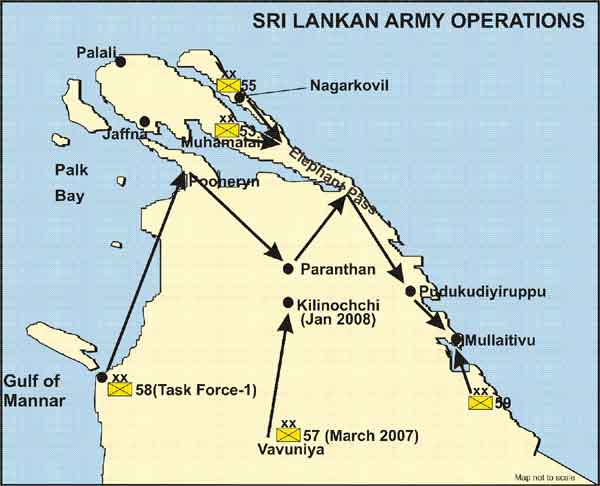
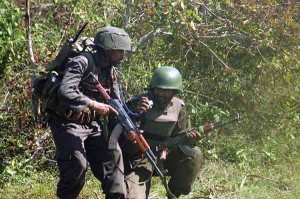
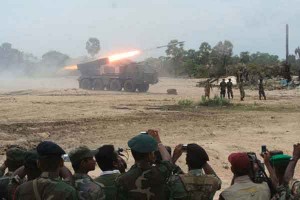
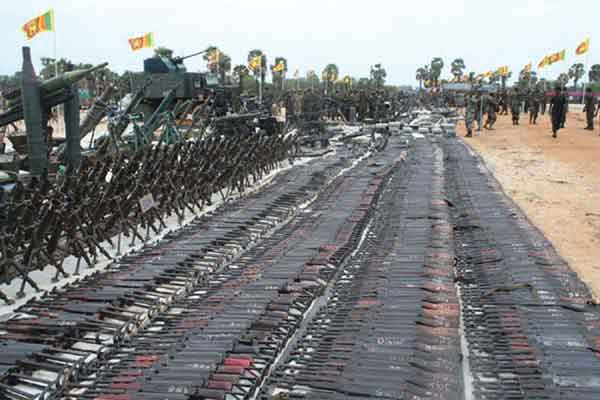
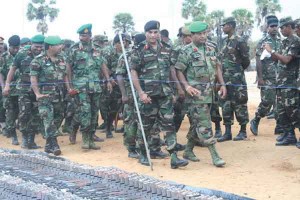
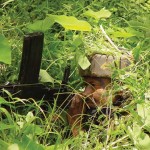
30 Countries fought supplied unlimited weapons against LTTE.
still it took 3 years to finish them
Seems they are the real heroes.
Have you thought about the war crimes and crimes against humanity committed by Srilankan army you are praising?
And why don’t you write about the India’s role in the massacre of innocents?
War crimes after war both parties ltte GOSL responsible mostly ltte killed so-many civilians ltte killed 800 police personnel who surrendered to them its the biggest crime and in Mulative 1800 army some of them surrendered to them
Finally no body won the war as many Tamils Sinhalese died we need not war we need tamil people ( representing last king of Sri Lanka ) to live with us with peace and harmony we need them their capabilities to develop this country
Whatever done by Srilankan armed force to Srilankan Tamils were done by Indian armed force in the end of 1980’s.
In his 2017 book, Mission Overseas, army officer turned journalist Sushant Singh describes an incident in which two Indian soldiers entered a militant’s house and shot dead a woman inside. They next saw her 2-year-old son, who reminded one of the soldiers of his own child back home. “Then I told myself that this child will grow up to be a terrorist, perhaps a suicide bomber,” this soldier recalls in Singh’s book. His platoon mate killed the boy, a decision this soldier tells Singh, “I will regret all my life.”
Now India should learn from Sri lanka, They had proper plan and time line. Everything did under Gotabaya Rajapaksha.
I think he is the best war planner in the Asia.
A Frank and well written article it highlights both political and military aspect of Lankan victory